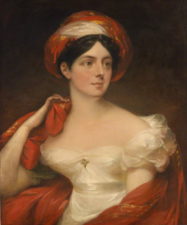29 March. On this day in 1906 Martin Ross (born Violet Florence Martin) made her will, leaving her worldly possessions (including her literary copyrights) to her second cousin and literary collaborator Edith Somerville. This was an obvious disposition of her literary legacy, since the two women were inseparable and the partnership “Somerville and Ross” was famous in a way that neither writer was alone. Ross lived nearly another ten years after this. She died on 21 December 1915, and Somerville wrote in her diary: “This black, black year goes out in despair and tears.” The two most famous Somerville and Ross novels, The Real Charlotte and Some Experiences of an Irish R. M., appeared before Ross made her will; between those and her death, four more vintage titles followed.
Ross would have been well acquainted with Somerville’s interest in spiritualism, which dated from her teenage years and was intensified by the deaths of her parents in the 1890s. Nevertheless Ross might have been surprised had she known that after her death Somerville would go on to publish another seventeen books as collaborations between them. Six months dead, it seems, Ross sent a message through a medium to her partner: “You and I have not finished our work. Dear, we shall.” Later attempts to get her to manifest herself at spiritualist seances proved unsuccessful or inconclusive, yet she apparently collaborated willingly, even on the stories in Stray-aways, 1920, many of which involve spiritualism and the occult. When, on Somerville’s ninetieth birthday, her nephew Professor Nevill Coghill broadcast a BBC talk about her, she thought it beautifully done but wished he had said more about Ross.
According to Orlando: Women’s Writing in the British Isles from the Beginnings to the Present, Somerville’s family (which was Ross’s too) “sprang from the wealthy Anglo-Irish Protestant ascendancy. In her lifetime the value of land and rents declined so that cash became extremely short. Luxuries and sometimes near-necessities were sacrificed to keep a beloved, archaic way of life ticking over.” Somerville ran the family estate: horses were profitable, just, but the dairy herd was not.
She and Ross were suffragist supporters. After Ross’s death Somerville “signed a petition on behalf of the condemned leaders of the Easter Rising,” and she tried to overcome Ethel Smyth’s English prejudice and persuade her that the Black and Tans were worse than Sinn Fein. She had brothers in the British Army and called herself politically a “half rebel”, a “Miss-Facing-both-ways.” But Orlando says that she wrote of Republicans hanged as traitors: “Whatever their methods were, those men died for their country just like any other patriots.”
Somerville and Ross’s most famous writings are hilarious and on the surface apolitical. The “Irish R.M.” (or Regional Magistrate) is a young Englishman with Irish forebears who has wangled a job in the subordinate sister kingdom, which he finds “a kind of Arcadia of childish play, a holiday of the spirit.” With minimal experience of riding, he adapts to a life revolving around horses and fox-hunting. Yet he is treading in footsteps well-worn by Irish writers addressing English readers, ever since Sydney Owenson (later Lady Morgan) in The Wild Irish Girl, 1806, and Maria Edgeworth in “Ennui”, 1809. In each a young Englishman, ignorant or prejudiced about Ireland and possessing some degree of power or authority, is re-educated by Irish experience. Owenson’s Horatio Mortimer relates himself to Ireland by falling in love with Lady Glorvina, “poet, harpist, and intellectual, daughter of the Prince of Inishmore” — a scion, that is, of the ancient Celtic nobility. Edgeworth’s Lord Glenthorn, apparently the son of a foolish, heartless expatriate landowning couple, relates himself to Ireland by discovering that he is biologically the son of his Irish wetnurse, who swapped him with her employers’ baby.
In each case it is a woman (Lady Glorvina, the wetnurse) who effects the re-education. The Irish R.M., too, owes his conversion less to Flurry Knox, master of the local foxhounds, than to Flurry’s redoubtable grandmother. Mrs Knox ages over three volumes from ‘eighty-three if she’s a day’ to somewhere near a hundred, but she is impossible to condescend to. “She was a daredevil rider in her youth . . . and dresses ‘as if she had robbed a scarecrow,’ with a magnificent diamond ring on her dirt-engrained gardener’s hand.” Her grandson’s Christian names – he is officially Florence McCarthy Knox – probably allude to Lady Morgan’s novel Florence Macarthy, 1818, as well as to the actual, male Florence Macarthy who rebelled against Queen Elizabeth I. Mrs. Knox is just as resistant to authority (except her own authority) as her grandson or his namesake.
The partnership of Somerville and Rose deserves to be better known – although Ross does seem to have lost some of her creative power when she died.
All information here is from Orlando, an electronic resource published by Cambridge University Press, by subscription, at http://orlando.cambridge.org

